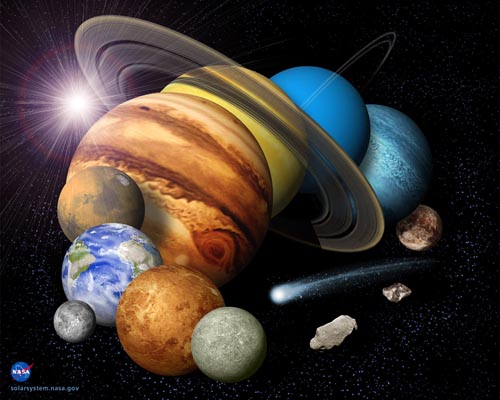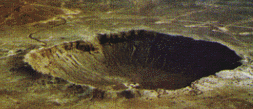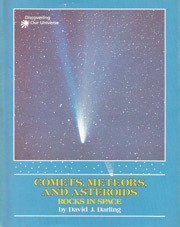COMETS, METEORS, AND ASTEROIDS: 1. Beware, Low-Flying Space Rocks

Some of the objects in the Solar System.
On the morning of June 30, 1908, in a lonely Russian valley, there was a huge explosion. Tall trees were laid flat across a wide area, and the bang was felt hundreds of miles away. Whatever had caused the explosion had come from outer space.
Could it have been an alien spaceship that lost control while trying to land? Was it perhaps a tiny "black hole" that came to Earth from a distant part of the universe? These are among many explanations that have been put forward over the years. But scientists now think that the likeliest cause of the famous Tunguska event, as it's called, was a chunk of a COMET that burst apart as it rushed through our atmosphere.
In 1937, a mountain-sized boulder called Hermes whizzed by the Earth at a distance of just 500,000 miles (800,000 kilometers). As quickly as it came, it vanished again into the depths of space. More recently, on March 18, 2004, another runaway rock, named 2004 FH, about the size of an office building, came even closer. It zipped past us just 25,000 miles (40,000 kilometers) away – about one-tenth the distance of the Moon. Both Hermes and 2004 FH were visiting ASTEROIDS.
 |
|
The Barringer crater in Arizona
|
In almost any science museum, you'll find examples of smaller space rocks, called METEORITES, that have crashed into the Earth. But not all meteorites are small. If you travel to the northern Arizona desert, you can see the great Barringer crater. This three-quarter-mile-wide pit was made thousands of years ago by a giant meteorite. If you gaze into the sky on an clear night, you may see bright streaks of light, or shooting stars. These are caused by tiny METEORS burning up as they plunge into the Earth's atmosphere.
What could be more thrilling than these strange, often unexpected visitors? They bring with them matter that has journeyed for trillions of miles and that is billions of years old. They have traveled through regions that no human eye has ever seen. And the comets, asteroids, and meteors that crash into, or pass close by, the Earth are just a few of the billions that wander through our neighborhood of space.
The Kingdom of the Sun
The part of space in which we live is called the SOLAR SYSTEM. It contains the Sun, an ordinary, yellow star, and all the objects that go around it.
In terms of size and mass, the Sun is the most important member of the solar system. Because of its great mass, it has a strong pull of gravity. And because of its strong pull of gravity, the Sun forces everything else in its kingdom to move around it in huge curved paths called orbits.
Biggest of the orbiting objects are the planets. There are nine of these, ranging in size from mighty Jupiter, at 88,700 miles (142,700 kilometers) in diameter, to tiny Pluto, at just 1,442 miles (2,320 kilometers). Recently, Pluto was demoted to the class of "dwarf planet."
Next come the moons, or satellites, of the planets. Like our own Moon, these objects orbit about their parent worlds. The largest of them is Jupiter's Ganymede, with a diameter of 3,278 miles (5,274 kilometers). Smallest are the odd-shaped moons, such as Mars's Deimos, which is only 9 miles (14½ kilometers) across.
Finally, come the comets, meteors, and asteroids. They are small in size, ranging from an asteroids 623 miles (1,003 kilometers) in diameter to tiny meteors too small to be seen. But they are huge in number. Scientists already know of hundreds of comets and thousands of asteroids. Countless more are waiting to be discovered. Some have been visited by spacecraft and there are plans for even more daring missions to these small, wandering bodies to uncover the secrets that are locked within them.

